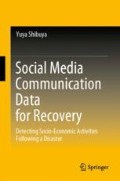Abstract
The goal of this chapter is to demonstrate there was excess demand for dry houses after Hurricane Sandy in New York City, and thus to support the appropriateness of using housing market data as a proxy of one of the socio-economic recovery activity indicators (RQ1b). This chapter, therefore, examines how the housing market data in New York City was impacted by Hurricane Sandy by conducting quantitative research based on the methodology introduced in Chap. 3. This chapter is constructed as follows: In Sect. 10.1, the author reviews the housing market data for analysis. Section 10.2 introduces a model based on the methodology shown in Chap. 3. The results of the analysis are described in Sect. 10.3. Section 10.4 discusses the results and concludes the chapter.
Access this chapter
Tax calculation will be finalised at checkout
Purchases are for personal use only
Notes
- 1.
Chapters 10 and 11 are a revised version of Shibuya and Tanaka (2018).
- 2.
https://www1.nyc.gov/site/finance/taxes/property-annualized-sales-update.page (accessed July 6th, 2018). Other related open data is the CaseShiller index (https://jp.spindices.com/index-family/real-estate/sp-corelogic-case-shiller, accessed October 29th, 2018). The index measures the residential housing market in 10 metropolitan regions across the US, namely, Boston, Chicago, Denver, Las Vegas, Los Angeles, Miami, New York, San Diego, San Francisco, and Washington DC. However the index is only available at regional levels and does not allow analyses about the hurricane’s effect on each small area, such as each borough.
- 3.
Although New York City’s open data include other property types, such as apartment buildings and commercial buildings, the records of these types are relatively limited for this analysis. Therefore, this study only analyzes one-and-two-family homes data.
- 4.
The number of records of one-and-two-family homes in Manhattan is relatively small compared to the other boroughs. Therefore, the analysis excludes the housing record in Manhattan.
- 5.
https://www1.nyc.gov/site/planning/data-maps/open-data/dwn-pluto-mappluto (accessed July 6th, 2018).
- 6.
https://www.arcgis.com/home/item.html?id=307dd522499d4a44a33d7296a5da5ea0 (accessed July 6th, 2018).
- 7.
For example, the lower 95% confidence limit of November in 2012 is compared with the upper 95% confidence limit of November in 2011. The lower 95% confidence limit of November in 2013 is also compared with the upper 95% confidence limit of the November in 2011.
References
Barr, J., Cohen, J. P., & Kim, E. (2017). Storm surges, informational shocks, and the price of urban real estate: An application to the case of Hurricane Sandy. Rutgers University, Newark 2017-002, Department of Economics, Rutgers University, Newark. https://sasn.rutgers.edu/academics-admissions/academic-departments/economics/faculty-publications, working paper.
Bin, O., & Landry, C. E. (2013). Changes in implicit flood risk premiums: Empirical evidence from the housing market. Journal of Environmental Economics and Management65(3). https://doi.org/10.1016/j.jeem.2012.12.002.
Hallstrom, D. G., & Smith, V. K. (2005). Market responses to hurricanes. Journal of Environmental Economics and Management, 50(3), 541–561. https://doi.org/10.1016/j.jeem.2005.05.002.
McKenzie, R., & Levendis, J. (2010). Flood hazards and urban housing markets: The effects of Katrina on New Orleans. Journal of Real Estate Finance and Economics, 40(1), 62–76. https://doi.org/10.1007/s11146-008-9141-3.
Nyce, C., Dumm, R. E., Sirmans, G. S., & Smersh, G. (2015). The capitalization of insurance premiums in house prices. Journal of Risk and Insurance, 82(4), 891–919. https://doi.org/10.1111/jori.12041.
Shibuya, Y., & Tanaka, H. (2018) Does sentiment of social media sense mid-to long-term socio-economic disaster recovery? a case study of Hurricane Sandy focusing on housing demand. In Proceedings of the 17th International Conference of the Japanese Economic Policy Association.
Tatsuki, S. (2007). Long-term Life Recovery Processes Among Survivors of the and 2005 Life Recovery Social Survey Results. Journal of Disaster Research, 2(6), 484–501.
Tatsuki, S. (2009). Impact Stabilization and Event Evaluation for Life Recovery among the 1995 Kobe Earthquake Survivors and 2005 Cross-sectional and Longitudinal Life Recovery Social Survey Findings). In Proceedings of international conference in commemoration of the 10th anniversary of the 1999 chi-chi earthquake. Taipei, Taiwan.
Tatsuki, S., Hayashi, H., Yamori, K., Noda, T., Tamura, K., & Kimura, R. (2005). Long-term Life Recovery process of the Survivors of the 1995 Kobe Earthquake: Causal Modeling Analysis of The Hyogo Prefecture Life Recovery Panel Survey Data. In Proceedings of the first international conference on urban disaster reduction. Hyogo, Japan.
Author information
Authors and Affiliations
Corresponding author
Rights and permissions
Copyright information
© 2020 Springer Nature Singapore Pte Ltd.
About this chapter
Cite this chapter
Shibuya, Y. (2020). The Excess Demand for Housing After Sandy. In: Social Media Communication Data for Recovery. Springer, Singapore. https://doi.org/10.1007/978-981-15-0825-7_10
Download citation
DOI: https://doi.org/10.1007/978-981-15-0825-7_10
Published:
Publisher Name: Springer, Singapore
Print ISBN: 978-981-15-0824-0
Online ISBN: 978-981-15-0825-7
eBook Packages: Business and ManagementBusiness and Management (R0)

